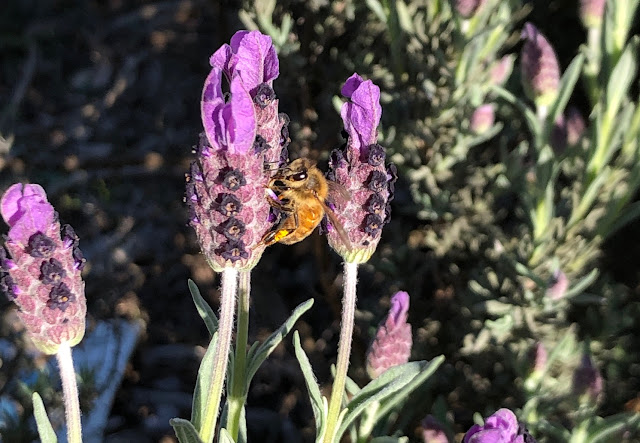
Resources to view during those too-hot-to-garden times

|
|
Pollinators are the subject of an upcoming webinar from the Placer County master gardeners. (Photo:
Kathy Morrison)
|
Around here, mornings in spring are made for gardening. But if — when! — the weather heats up, ome inside and spend some time online with the many resources available from the University of California Agriculture and Natural Resources, including the UC Cooperative Extension.
Check out these online events and webinars:
-- Principles of Propagation Zoom Workshop, 10:30-11:30 a.m. Saturday, May 8, presented by the Placer County master gardeners. As they note: "Propagation is the term for the multiplication of plants, either by natural means or by the actions of the nurseryman or gardener. This introductory workshop will show you some of the many ways you can propagate plants." Click here for the Zoom link and password .
-- Heat Illness Prevention and Environmental Hazards in Your Garden, 9 a.m. to 10:30 a.m. Wednesday, May 12. This timely virtual presentation is from the El Dorado County master gardeners. "Prevention is key to avoiding heat related illnesses and potential injuries and illnesses associated with environmental hazards, such as rattlesnakes, poisonous plants, skin cancer, insect bites, etc. Join Master Gardener Cathie Mankins to learn tips on preventing illnesses and injuries in your garden." Registration is free but required .
-- Springtime Household Pests, 1 p.m. Thursday, May 20. This 1-hour webinar is part of a new monthly series from the UC Statewide Integrated Pest Management Program. "This webinar will cover identification and management of pests encountered in the home during springtime including carpet beetles, fleas, and fungus gnats associated with houseplants." The present is Dr. Andrew Sutherland, Area Urban IPM Advisor, San Francisco Bay Area. Free, but registration required here . The June 17 webinar will be "IM for Rodents." For more on the IPM series, visit this page .
-- Plant It and They Will Come: Planning for Pollinators Zoom Workshop, 10:30-11:30 a.m. Saturday, May 22, also by the Placer County master gardeners. "Learn how to attract and support bees, butterflies and other pollinators by choosing a palette of plants that provide a living landscape which offers nourishment and nesting places for these creatures that enliven our gardens, as well as provide pollination services. It’s a win-win for humans and pollinators!" Go here for the Zoom link and password .
Several view-anytime videos are linked from the Sacramento County master gardeners video library . Here are a few that are relevant right now:
"Better Pollination In The Home Vegetable Garden," from the Honey Bee Haven at UC Davis.
"Thinning Fruit on Your Fruit Trees," by the Sacramento County master gardeners.
"Aphid-eating Insects in Action!" The focus is on beneficial insects that devour (and I mean devour, wow!) bad bugs, from UC IPM.
Comments
0 comments have been posted.Sacramento Digs Gardening to your inbox.
Sites We Like
Garden Checklist for week of May 12
Get your gardening chores and irrigation done early in the day before temperatures rise.
* Plant, plant, plant! It’s prime planting season in the Sacramento area. Time to set out those tomato transplants along with peppers and eggplants. Pinch off any flowers on new transplants to make them concentrate on establishing roots instead of setting premature fruit.
* Direct-seed melons, cucumbers, summer squash, corn, radishes, pumpkins and annual herbs such as basil.
* Harvest cabbage, lettuce, peas and green onions. This heat will cause leafy greens and onions to flower; pick them before they bolt.
* In the flower garden, direct-seed sunflowers, cosmos, salvia, zinnias, marigolds, celosia and asters.
* Plant dahlia tubers. Other perennials to set out include verbena, coreopsis, coneflower and astilbe.
* Transplant petunias, marigolds and perennial flowers such as astilbe, columbine, coneflowers, coreopsis, dahlias, rudbeckia and verbena.
* Keep an eye out for slugs, snails, earwigs and aphids that want to dine on tender new growth.
* Feed summer bloomers with a balanced fertilizer.
* For continued bloom, cut off spent flowers on roses as well as other flowering plants.
* Got fruit trees? If you haven't already done so, thin orchard fruit such as apples, peaches, pears, pluots and plums before they grow too heavy, breaking branches or even splitting the tree. Leave the largest fruit on the branch, culling the smaller ones, and allow for 5 to 6 inches (or a hand's worth) between each fruit.
* Thin grape bunches, again leaving about 6 inches between them. For the remaining bunches, prune off the "tail" end, about the bottom third of the bunch, so that the plant's energy is concentrated in the fruit closest to the branch.
* As spring-flowering shrubs finish blooming, give them a little pruning to shape them, removing old and dead wood. Lightly trim azaleas, fuchsias and marguerites for bushier plants.
* Add mulch to the garden to help keep that precious water from evaporating. Mulch also cuts down on weeds. But don’t let it mound around the stems or trunks of trees or shrubs. Leave about a 6-inch to 1-foot circle to avoid crown rot or other problems.